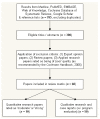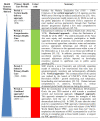The architecture and effect of participation: a systematic review of community participation for communicable disease control and elimination. Implications for malaria elimination
- PMID: 21816085
- PMCID: PMC3171376
- DOI: 10.1186/1475-2875-10-225
The architecture and effect of participation: a systematic review of community participation for communicable disease control and elimination. Implications for malaria elimination
Abstract
Background: Community engagement and participation has played a critical role in successful disease control and elimination campaigns in many countries. Despite this, its benefits for malaria control and elimination are yet to be fully realized. This may be due to a limited understanding of the influences on participation in developing countries as well as inadequate investment in infrastructure and resources to support sustainable community participation. This paper reports the findings of an atypical systematic review of 60 years of literature in order to arrive at a more comprehensive awareness of the constructs of participation for communicable disease control and elimination and provide guidance for the current malaria elimination campaign.
Methods: Evidence derived from quantitative research was considered both independently and collectively with qualitative research papers and case reports. All papers included in the review were systematically coded using a pre-determined qualitative coding matrix that identified influences on community participation at the individual, household, community and government/civil society levels. Colour coding was also carried out to reflect the key primary health care period in which community participation programmes originated. These processes allowed exhaustive content analysis and synthesis of data in an attempt to realize conceptual development beyond that able to be achieved by individual empirical studies or case reports.
Results: Of the 60 papers meeting the selection criteria, only four studies attempted to determine the effect of community participation on disease transmission. Due to inherent differences in their design, interventions and outcome measures, results could not be compared. However, these studies showed statistically significant reductions in disease incidence or prevalence using various forms of community participation. The use of locally selected volunteers provided with adequate training, supervision and resources are common and important elements of the success of the interventions in these studies. In addition, qualitative synthesis of all 60 papers elucidates the complex architecture of community participation for communicable disease control and elimination which is presented herein.
Conclusions: The current global malaria elimination campaign calls for a health systems strengthening approach to provide an enabling environment for programmes in developing countries. In order to realize the benefits of this approach it is vital to provide adequate investment in the 'people' component of health systems and understand the multi-level factors that influence their participation. The challenges of strengthening this component of health systems are discussed, as is the importance of ensuring that current global malaria elimination efforts do not derail renewed momentum towards the comprehensive primary health care approach. It is recommended that the application of the results of this systematic review be considered for other diseases of poverty in order to harmonize efforts at building 'competent communities' for communicable disease control and optimising health system effectiveness.
Figures
























References
-
- Najera JA. Malaria control: achievements, problems and strategies. Parassitologia. 2001;43:1–89. - PubMed
-
- Sharma VP. Re-emergence of malaria in India. Indian J Med Res. 1996;103:26–45. - PubMed
-
- Peters W. A critical review of the results of malaria eradication and control programs of the South West Pacific. Ann Trop Med Parasitol. 1962;56:20–32. - PubMed
Publication types
MeSH terms
LinkOut - more resources
Full Text Sources
Medical
Molecular Biology Databases

